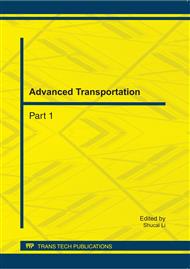p.305
p.311
p.316
p.321
p.327
p.334
p.340
p.347
p.352
Research on the Rail Transit Station Spacing Based on Passenger Travel Choice
Abstract:
From the traveler’s view, this paper uses random utility theory of the disaggregate model to construct travelers transportation choice model, employ software STATA to calibrate parameter for getting utility function for prediction, and then employ the critical condition which make rail transit and regular transit coordinated to calculate reasonable rail transit station spacing. Finally, example is given, the results show that rail transit station spacing based on passenger travel choice, make rail transit and regular transit to achieve harmonization and complementarities, and improve overall operating efficiency of urban transit system.
Info:
Periodical:
Pages:
327-333
Citation:
Online since:
September 2011
Authors:
Price:
Сopyright:
© 2011 Trans Tech Publications Ltd. All Rights Reserved
Share:
Citation:


